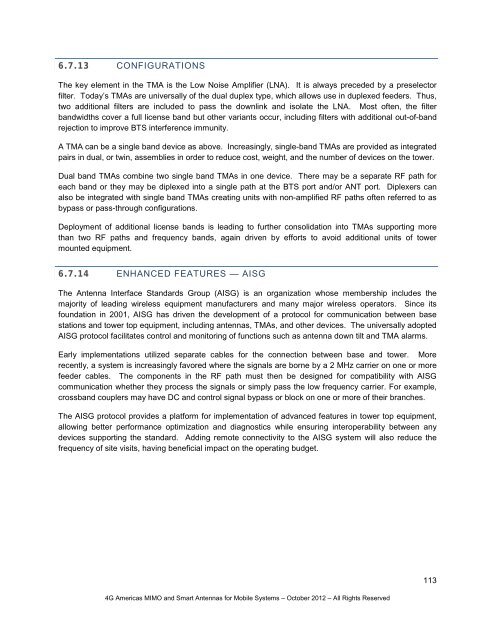MIMO and Smart Antennas for Mobile Broadband ... - 4G Americas
MIMO and Smart Antennas for Mobile Broadband ... - 4G Americas
MIMO and Smart Antennas for Mobile Broadband ... - 4G Americas
You also want an ePaper? Increase the reach of your titles
YUMPU automatically turns print PDFs into web optimized ePapers that Google loves.
6.7.13 CONFIGURATIONSThe key element in the TMA is the Low Noise Amplifier (LNA). It is always preceded by a preselectorfilter. Today’s TMAs are universally of the dual duplex type, which allows use in duplexed feeders. Thus,two additional filters are included to pass the downlink <strong>and</strong> isolate the LNA. Most often, the filterb<strong>and</strong>widths cover a full license b<strong>and</strong> but other variants occur, including filters with additional out-of-b<strong>and</strong>rejection to improve BTS interference immunity.A TMA can be a single b<strong>and</strong> device as above. Increasingly, single-b<strong>and</strong> TMAs are provided as integratedpairs in dual, or twin, assemblies in order to reduce cost, weight, <strong>and</strong> the number of devices on the tower.Dual b<strong>and</strong> TMAs combine two single b<strong>and</strong> TMAs in one device. There may be a separate RF path <strong>for</strong>each b<strong>and</strong> or they may be diplexed into a single path at the BTS port <strong>and</strong>/or ANT port. Diplexers canalso be integrated with single b<strong>and</strong> TMAs creating units with non-amplified RF paths often referred to asbypass or pass-through configurations.Deployment of additional license b<strong>and</strong>s is leading to further consolidation into TMAs supporting morethan two RF paths <strong>and</strong> frequency b<strong>and</strong>s, again driven by ef<strong>for</strong>ts to avoid additional units of towermounted equipment.6.7.14 ENHANCED FEATURES — AISGThe Antenna Interface St<strong>and</strong>ards Group (AISG) is an organization whose membership includes themajority of leading wireless equipment manufacturers <strong>and</strong> many major wireless operators. Since itsfoundation in 2001, AISG has driven the development of a protocol <strong>for</strong> communication between basestations <strong>and</strong> tower top equipment, including antennas, TMAs, <strong>and</strong> other devices. The universally adoptedAISG protocol facilitates control <strong>and</strong> monitoring of functions such as antenna down tilt <strong>and</strong> TMA alarms.Early implementations utilized separate cables <strong>for</strong> the connection between base <strong>and</strong> tower. Morerecently, a system is increasingly favored where the signals are borne by a 2 MHz carrier on one or morefeeder cables. The components in the RF path must then be designed <strong>for</strong> compatibility with AISGcommunication whether they process the signals or simply pass the low frequency carrier. For example,crossb<strong>and</strong> couplers may have DC <strong>and</strong> control signal bypass or block on one or more of their branches.The AISG protocol provides a plat<strong>for</strong>m <strong>for</strong> implementation of advanced features in tower top equipment,allowing better per<strong>for</strong>mance optimization <strong>and</strong> diagnostics while ensuring interoperability between anydevices supporting the st<strong>and</strong>ard. Adding remote connectivity to the AISG system will also reduce thefrequency of site visits, having beneficial impact on the operating budget.<strong>4G</strong> <strong>Americas</strong> <strong>MIMO</strong> <strong>and</strong> <strong>Smart</strong> <strong>Antennas</strong> <strong>for</strong> <strong>Mobile</strong> Systems – October 2012 – All Rights Reserved113
















